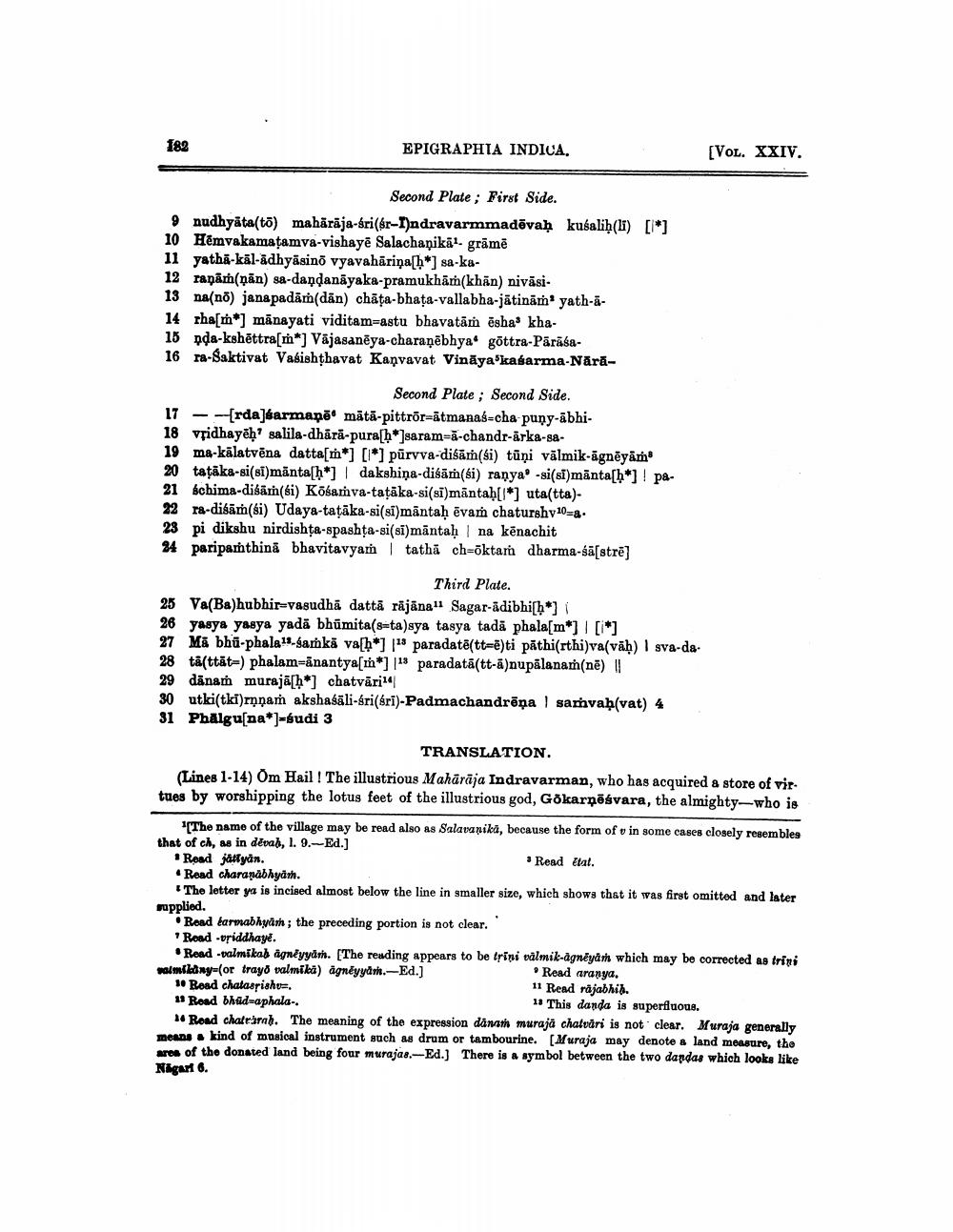________________
182
EPIGRAPHIA INDICA,
Second Plate; First Side.
9 nudhyata(to) mahārāja-éri(ár-Indravarmmadevah kusalib() [] 10 Hêmvakamatamva-vishaye Salachanikā1- grāmē
11 yatha-kal-adhyasino vyavahāriņa[h*] sa-ka
12 rapām(pan) sa-dandanayaka-pramukhām(khan) nivasi
13 na(no) janapadam(dan) chața-bhata-vallabha-jātinām3 yath-a
14 rha[m] manayati viditam-astu bhavatām esha kha
15 pda-kshēttra[m*] Vajasaneya-charanebhya gōttra-Pārāśa16 ra-Saktivat Vasishthavat Kanvavat Vinaya kasarma-Nārā
Second Plate; Second Side. 17rda]éarmane mätä-pittror-ätmanas-cha puny-abhi18 vridhayeḥ salila-dhara-pura[h*]saram-a-chandr-arka-sa19 ma-kalatvēna datta[m*] [*] pūrvva-disām(si) tūņi välmik-agnēyām
20 taṭāka-si(si)mänta[h*]| dakshina-disām(si) ranya -si(si)manta[h*]! pa
21 schima-disam(si) Kōsamva-taṭaka-si(si)mäntaḥ[*] uta(tta)
22 ra-disām (si) Udaya-taṭaka-si(si)mantaḥ ēvam chaturshy 10-a.
23 pi dikshu nirdishta-spashta-si(si)mantaḥ na kēnachit
24 paripamthina bhavitavyam tatha ch-ōktam dharma-sa[strē]
Third Plate.
25 Va(Ba)hubhir-vasudha datta rajāna" Sagar-ādibhi[h*] [
26 yasya yasya yada bhumita (s-ta)sya tasya tada phala[m*] | [*]
27 Ma bhu-phala1-samka vah*] 18 paradate(tt-e)ti pathi(rthi)va(vah) I sva-da28 tttt) phalam-Anantya[*] paradata(tt-nuplanath(në) I
29 danam murajah*] chatväri14
1
30 utki(tki)rņņam akshaśäli-śri(śrī)-Padmachandrēņa | samvaḥ(vat) 4 31 Phalgu[na*]-sudi 3
[VOL. XXIV.
TRANSLATION.
(Lines 1-14) Om Hail! The illustrious Mahārāja Indravarman, who has acquired a store of vir tues by worshipping the lotus feet of the illustrious god, Gōkarnesvara, the almighty-who is
[The name of the village may be read also as Salavanika, because the form of in some cases closely resembles that of ch, as in devab, 1. 9.-Ed.]
Read jättyän.
Read état.
Read charanabhyām.
The letter ya is incised almost below the line in smaller size, which shows that it was first omitted and later supplied.
Read farmabhyam; the preceding portion is not clear.
"Read -vriddhaye.
Read -valmikab agneyyam. [The reading appears to be trini välmik-agnēyām which may be corrected as trini valmikiny (or trayö valmikä) ägněyyam.-Ed.]
10 Read chatasrish.
13 Read bhüd-aphala-.
Read aranya.
11 Read rajabhib.
13 This danda is superfluous.
14 Read chatrirah. The meaning of the expression danam muraja chatväri is not clear. Muraja generally means a kind of musical instrument such as drum or tambourine. [Muraja may denote a land measure, the area of the donated land being four murajas.-Ed.] There is a symbol between the two dandas which looks like Nagari 6.




